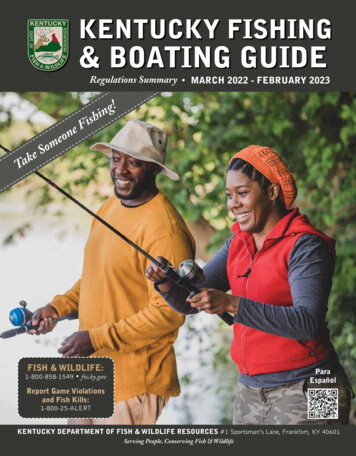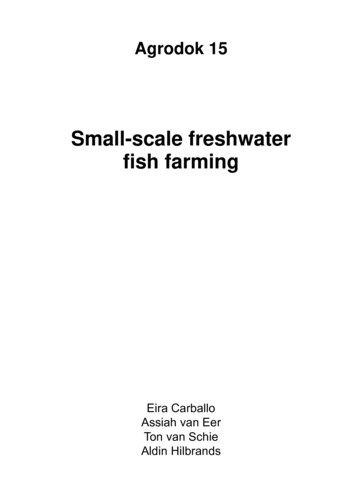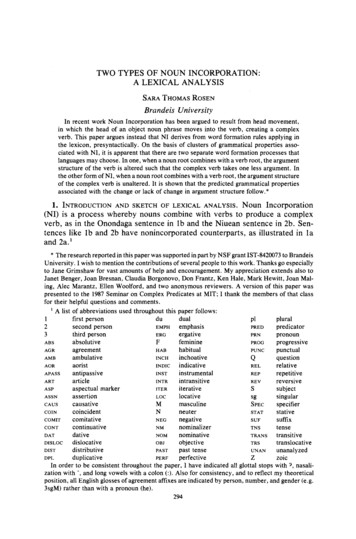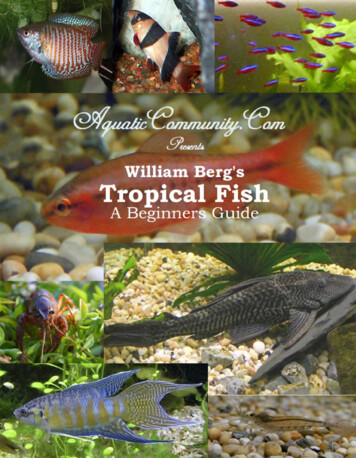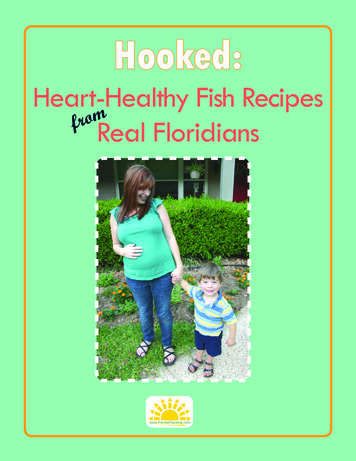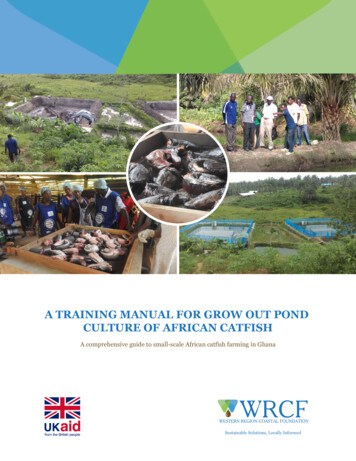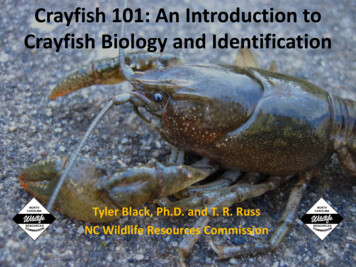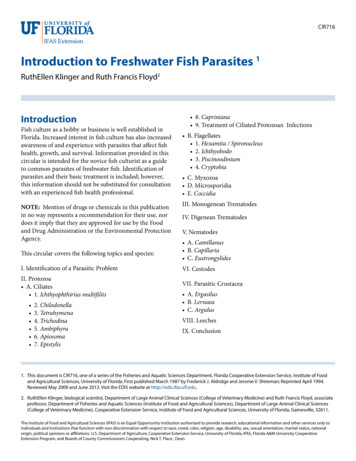
Transcription
CIR716Introduction to Freshwater Fish Parasites 1RuthEllen Klinger and Ruth Francis Floyd2IntroductionFish culture as a hobby or business is well established inFlorida. Increased interest in fish culture has also increasedawareness of and experience with parasites that affect fishhealth, growth, and survival. Information provided in thiscircular is intended for the novice fish culturist as a guideto common parasites of freshwater fish. Identification ofparasites and their basic treatment is included; however,this information should not be substituted for consultationwith an experienced fish health professional.NOTE: Mention of drugs or chemicals in this publicationin no way represents a recommendation for their use, nordoes it imply that they are approved for use by the Foodand Drug Administration or the Environmental ProtectionAgency. 8. Capriniana 9. Treatment of Ciliated Protozoan Infections B. Flagellates 1. Hexamita / Spironucleus 2. Ichthyobodo 3. Piscinoodinium 4. Cryptobia C. Myxozoa D. Microsporidia E. CoccidiaIII. Monogenean TrematodesIV. Digenean TrematodesV. NematodesThis circular covers the following topics and species: A. Camillanus B. Capillaria C. EustrongylidesI. Identification of a Parasitic ProblemVI. CestodesII. Protozoa A. Ciliates 1. Ichthyophthirius multifiliisVII. Parasitic Crustacea 2. Chilodonella3. Tetrahymena4. Trichodina5. Ambiphyra6. Apiosoma7. Epistylis A. Ergasilus B. Lernaea C. ArgulusVIII. LeechesIX. Conclusion1. This document is CIR716, one of a series of the Fisheries and Aquatic Sciences Department, Florida Cooperative Extension Service, Institute of Foodand Agricultural Sciences, University of Florida. First published March 1987 by Frederick J. Aldridge and Jerome V. Shireman; Reprinted April 1994.Reviewed May 2009 and June 2013. Visit the EDIS website at http://edis.ifas.ufl.edu.2. RuthEllen Klinger, biological scientist, Department of Large Animal Clinical Sciences (College of Veterinary Medicine) and Ruth Francis Floyd, associateprofessor, Department of Fisheries and Aquatic Sciences (Institute of Food and Agricultural Sciences), Department of Large Animal Clinical Sciences(College of Veterinary Medicine), Cooperative Extension Service, Institute of Food and Agricultural Sciences, University of Florida, Gainesville, 32611.The Institute of Food and Agricultural Sciences (IFAS) is an Equal Opportunity Institution authorized to provide research, educational information and other services only toindividuals and institutions that function with non-discrimination with respect to race, creed, color, religion, age, disability, sex, sexual orientation, marital status, nationalorigin, political opinions or affiliations. U.S. Department of Agriculture, Cooperative Extension Service, University of Florida, IFAS, Florida A&M University CooperativeExtension Program, and Boards of County Commissioners Cooperating. Nick T. Place , Dean
Identification of a ParasiticProblemA common mistake of fish culturists is misdiagnosingdisease problems and treating their sick fish with the wrongmedication or chemical. When the chemical doesn’t work,they will try another, then another. Selecting the wrongtreatment because of misdiagnosis is a waste of time andmoney and may be more detrimental to the fish than notreatment at all. The majority of fish parasites can only beidentified by the use of a microscope. If a microscope isunavailable, or the person using it has no previous experience with one, the diagnosis is difficult and questionable.Successful fish culturists learn by experience. Newcomersto the field need to learn the fundamentals of diagnosticprocedures and how to use a microscope to identifyparasites by attending short training courses. The followingdescriptions of common parasites can be used as referencesfor understanding a professional diagnostic report or as aquick reference for the experienced fish culturist.ProtozoaMost of the commonly encountered fish parasites areprotozoans. With practice, these can be among the easiestto identify, and are usually among the easiest to control.Protozoans are single-celled organisms, many of whichare free-living in the aquatic environment. Typically, nointermediate host is required for the parasite to reproduce(direct life cycle). Consequently, they can build up to veryhigh numbers when fish are crowded causing weight loss,debilitation, and mortality. Five groups of protozoans aredescribed in this publication: ciliates, flagellates, myxozoans, microsporidians, and coccidians. Parasitic protozoansin the latter three groups can be difficult or impossible tocontrol as discussed below.Symptoms typical of ciliates include skin and gill irritationdisplayed by flashing, rubbing, and rapid breathing.Ichthyophthirius multifiliisThe disease called “Ich” or “white spot disease” has beena problem to aquarists for generations. Fish infected withthis organism typically develop small blister-like raisedlesions along the body wall and/or fins. If the infectionis restricted to the gills, no white spots will be seen. Thegills will appear swollen and be covered with thick mucus.Identification of the parasite on the gills, skin, and/or fins isnecessary to conclude that fish has an “ich” infection. Themature parasite (Figure 1) is very large, up to 1000 µm indiameter, is very dark in color due to the thick cilia covering the entire cell, and moves with an amoeboid motion.Classically, I . multifiliis is identified by its large horseshoeshaped macronucleus. This feature is not always readilyvisible, however, and should not be the sole criterion foridentification. Immature forms of I . multifiliis are smallerand more translucent in appearance. Some individuals havesuggested that the immature forms of I . multifiliis resembleTetrahymena. Fortunately, scanning the preparation willusually reveal the presence of mature parasites and allowconfirmation of the diagnosis.CiliatesMost of the protozoans identified by aquarists will be ciliates. These organisms have tiny hair-like structures calledcilia that are used for locomotion and/or feeding. Ciliateshave a direct life cycle and many are common inhabitantsof pond-reared fish. Most species do not seem to botherhost fish until numbers become excessive. In aquaria, whichare usually closed systems, ciliates should be eliminated.Uncontrollable or recurrent infestations with ciliatedprotozoans are indicative of a husbandry problem. Many ofthe parasites proliferate in organic debris accumulated inthe bottom of a tank or vat. Ciliates are easily transmittedfrom tank to tank by nets, hoses, or caretakers’ wet hands.Introduction to Freshwater Fish ParasitesFigure 1.If only one parasite is seen, the entire system should betreated immediately. “Ich” is an obligate parasite andcapable of causing massive mortality within a shorttime. Because the encysted stage (Figure 2) is resistant tochemicals, a single treatment is not sufficient to treat “Ich”.2
Repeating the selected treatment (Table 1) every other day(at water temperatures 68--77 F) for three to five treatmentswill disrupt the life cycle and control the outbreak. Dailycleaning of the tank or vat helps to remove encysted formsthe organism (Figure 3). The organism is easily recognizedat 100X magnification. Chilodonella can be controlled withany of the chemicals listed in Table 1, and one treatment isusually adequate. Chilodonella has been eliminated in tanksusing recirculating water systems by maintaining 0.02% saltsolution.TetrahymenaTetrahymena is a protozoan commonly found living inorganic debris at the bottom of an aquarium or vat. Tetrahymena is a teardrop-shaped ciliate (Figure 4) that movesalong the outside of the host. The presence of Tetrahymenaon the body surface in low numbers (less than five organisms per low power field) is probably not significant. It iscommonly found on dead material and is associated withhigh organic loads. Therefore, observing Tetrahymena onfish, which have been on the tank bottom, does not implythe parasite is the primary cause of death. One treatment ofa chemical listed in Table 1 should be adequate for control.Figure 2.from the environment. For more information, see Extension Circular 920, Ichythyophthirius multifiliis (White Spot)Infections of Fish.ChilodonellaChilodonella is a ciliated protozoan that causes infectedfish to secrete excessive mucus. Infected fish may flashand show similar signs of irritation. Many fish die wheninfestations become moderate (five to nine organisms perlow power field on the microscope) to heavy (greater thanten organisms per low power field). Chilodonella is easilyidentified using a light microscope to examine scrapingsof skin mucus or gill filaments. It is a large, heart-shapedciliate (60 to 80 m) with bands of cilia along the long axis ofFigure 4.Identification of Tetrahymena internally is a significant butuntreatable problem. A common site of internal infectionis the eye. Affected fish will have one or both eyes markedlyenlarged (exophthalmia). Squash preparations made fromfresh material reveal large numbers ( 10 per low powerfield) of Tetrahymena associated with fluids in the eye. Fishinfected with Tetrahymena internally should be removedfrom the collection and destroyed.Figure 3.Introduction to Freshwater Fish Parasites3
TrichodinaTrichodina is one of the most common ciliates present onthe skin and gills of pond-reared fish. Low numbers (lessthan five organisms per low power field) are not harmful,but when fish are crowded or stressed, and water qualitydeteriorates, the parasite multiplies rapidly and causes serious damage. Typically, heavily infested fish do not eat welland lose condition. Weakened fish become susceptible toopportunistic bacterial pathogens in the water. Trichodinacan be observed on scrapings of skin mucus, fin, or on gillfilaments. Its erratic darting movement and the presenceof a circular, toothed disc within its body (Figure 5) easilyidentify it. Trichodina can be controlled with any of thetreatments from Table 1. One application should be sufficient. Correction of environmental problems is necessaryfor complete control.Figure 6.ApiosomaApiosoma, formerly known as Glossatella, is anothersedentary ciliate common on pond-reared fish. Apiosomacan cause disease if their numbers become excessive. Theorganism can be found on gills, skin, or fins. The vase-likeshape and oral cilia are characteristic (Figure 7). Apiosomacan be controlled with one application of one of the treatments from Table 1 .Figure 5.AmbiphyraAmbiphyra, previously called Scyphidia, is a sedentaryciliate that is found on the skin, fins, or gills of host fish. Itscylindrical shape, row of oral cilia, and middle bank of ciliaidentify Ambiphyra (Figure 6). It is common on pondreared fish, and when present in low numbers (less than fiveorganisms per low power field), it is not a problem. Highorganic loads and deterioration of water quality are oftenassociated with heavy, debilitating Ambiphyra infestations.This parasite can be controlled with one application of anyof the treatments listed in Table 1.Figure 7.Introduction to Freshwater Fish Parasites4
EpistylisEpistylis is a stalked ciliate that attaches to the skin orfins of the host. Epistylis is of greater concern than manyof the ciliates because it is believed to secrete proteolytic(“protein-eating”) enzymes that create a wound, suitable forbacterial invasion, at the attachment site. It is similar in appearance to Apiosoma except for the non-contractile longstalk (Figure 8) and its ability to form colonies. In contrastto the other ciliates discussed above, the preferred treatment for Epistylis is salt. Fish can be placed into a 0.02% saltsolution as an indefinite bath, or a 3% salt dip. More thanone treatment may be required to control the problem. Formore information, see IFAS Extension Fact Sheet VM-85,“Red Sore Disease” in Game Fish.Figure 9.Treatment of ciliated protozoaninfectionsFigure 8.CaprinianaCapriniana, historically called Trichophyra, is a sessileciliate that attaches to the host’s gills with a sucker. Theyhave characteristic cilia attached to an amorphous-shapedbody (Figure 9). In heavy infestations, Capriniana cancause respiratory distress in the host. One treatment from achemical listed in Table 1 should be adequate.Introduction to Freshwater Fish ParasitesSeveral chemicals commonly used to control ciliatedprotozoans in freshwater fish are listed below for yourconvenience. As stated above, most ciliate infestationsrespond to one chemical treatment; however, fish that donot improve as expected should be rechecked and retreatedif necessary. Overtreatment with chemicals can causeserious damage to fish. The reader is also highly encouraged to read Extension Publication 673 (Mississippi StateUniversity), Calculation of Treatments, and IFAS Fact SheetVM-78, Bath Treatments for Sick Fish .Copper sulfate is an excellent compound for use in ponds tocontrol external parasites and algae; however, it is extremelytoxic to fish. Its killing action is directly proportional to theconcentration of copper ions (Cu ) in the water. As thealkalinity of the water increases, the concentration of copper ions in solution decreases. Consequently, a therapeuticlevel of copper in water of high alkalinity would be lethalto fish in water of low alkalinity. Conversely, a therapeuticconcentration of copper in water of low alkalinity wouldbe insufficient to have the desired action in water of higheralkalinity. For this reason, the alkalinity of the water to betreated must be known in order to determine the amountof copper sulfate needed. The amount of copper sulfateneeded in mg/L is the total alkalinity (in mg/L) dividedby 100. For example, if the total alkalinity in a pond is 100mg/L, the concentration of copper sulfate needed would be100/100 or 1 mg/L. If you are unsure how to measure the5
alkalinity of your water, or have never used copper sulfate,contact your aquaculture Extension specialist for assistance.Never use copper sulfate in water that has a total alkalinityless than 50 mg/L.Because of its algicidal activity, copper sulfate can causedangerous oxygen depletions, particularly in warmweather. Emergency aeration should always be availablewhen copper sulfate is applied to your system or ponds.Copper sulfate should not be run through the biofilter on arecirculation system as it will kill the nitrifying bacteria. Ifpossible, tanks should be taken “off-line” during treatmentwith copper sulfate. If necessary, clean the biofilter manually to decrease organic debris and residual parasite load.For more information see IFAS Fact Sheet FA-13, Use ofCopper in Aquaculture and Farm Ponds.Potassium permanganate is effective against ciliates aswell as fungus and external columnaris bacteria, and itcan be used in a pond or vat. Multiple treatments withpotassium permanganate are not recommended as it canburn gills. Aeration should be available when potassiumpermanganate is used because it is an algicide and cancause an oxygen depletion. Potassium permanganate atthe prescribed dosage (2 mg/L) does not seem to affect thenitrifying bacteria in a biological filter; however, ammonia,nitrite, and pH should be closely monitored followingtreatment. See also IFAS Fact Sheets FA-23, The Use ofPotassium Permanganate in Fish Ponds, and FA-37, Use ofPotassium Permanganate to Control External Infections ofOrnamental Fish.a few fish before large numbers of fish are exposed. Fishspecies can react differently to various concentrations ofthe chemical; therefore, fish undergoing treatment must bemonitored closely for adverse reactions. If the fish negatively react to treatment, the chemical should be flushedimmediately from the system, or the fish should be movedto fresh water.FlagellatesFlagellated protozoans are small parasites that can infectfish externally and internally. They are characterized byone or more flagella that cause the parasite to move in awhip-like or jerky motion. Because of their small size, theirmovement, observed at 200 or 400x magnification underthe microscope, usually identifies flagellates. Commonflagellates that infest fish are given below.Hexamita /SpironucleusHexamita is a small (3 -- 18 m) intestinal parasite commonly found in the intestinal tract of freshwater fish(Figure 10). Sick fish are extremely thin and the abdomenmay be distended. The intestines may contain a yellowmucoid (mucus-like) material. Recent taxonomic studieshave labeled the intestinal flagellate of freshwater angelfishas Spironucleus. Hexamita or Sprironucleus can be diagnosed by making a squash preparation of the intestine andexamining it at 200 or 400x magnification. The flagellatescan be seen where the mucosa (intestinal lining) is broken.They move by spiraling and in heavy infestations, they willbe too numerous to be overlooked.Formalin is an excellent parasiticide for use in smallvolumes of water such as vats or aquaria. It is not recommended for pond use because it is a strong algicide andchemically removes oxygen from the water. Vigorousaeration should always be provided when formalin is used.See also IFAS Fact Sheet VM-77, Use of Formalin to ControlFish Parasites.Used in proper amounts, salt effectively controls protozoanson the gills, skin, and fins of fish. This is an effective treatment for small volumes of water such as aquaria or tanks.Use in ponds as a treatment is generally not recommendeddue to the large amount of salt and high cost of treatmentthat would be needed to be effective. Salt should never beused on fish that navigate by electrical field such as knifefishand elephant nose fish. See also IFAS Fact Sheet VM-86,The Use of Salt in Aquaculture.When using any treatment for fish, a bioassay (a test todetermine safe concentration) should be conducted onIntroduction to Freshwater Fish ParasitesFigure 10.6
The recommended treatment for Hexamita / Spironucleusis metronidazole (Flagyl). Metronidazole can be administered in a bath at a concentration of 5 mg/L (18.9 mg/gallon) every other day for three treatments. Medicatedfeed is even more effective at a dosage of 50 mg/kg bodyweight (or 10 mg/gm food) for five consecutive days. Seealso IFAS Fact Sheet VM-67, Management of Hexamita inOrnamental Cichlids.IFAS Fact Sheet VM-90, Amyloodinium Infections of MarineFish, the marine counterpart to Piscinoodinium.IchthyobodoIchthyobodo, formerly known as Costia, is a commonlyencountered external flagellate (Figure 11). Ichthyobodoinfected fish secrete copious amounts of mucus. Mucussecretion is so heavy that catfish farmers popularly referto the disease as “blue slime disease”. Infected angelfishalso produce excessive mucus that can give dark coloredfish a gray or blue coloration along the dorsal body wall.Infected fish flash and lose condition, often characterizedby a thin, unthrifty appearance. Ichthyobodo can be locatedon the gills, skin, and fins, however, it is difficult to identifybecause of its small size. The easiest way to identify Ichthyobodo is by its corkscrew swimming pattern. With a goodmicroscope, the attached organism can be seen at 400xmagnification. The organism is easily controlled using oneapplication of one of the treatments listed in Table 1.Figure 12.CryptobiaCryptobia is a flagellated protozoan common in cichlids.They are often mistaken for Hexamita as they are similarin appearance. However, Cryptobia are more drop-shaped,with two flagella, one on each end. Also, Cryptobia“wiggles” in a dart-like manner, whereas Hexamita“spirals”. Cryptobia typically is associated with granulomas(Figure 13), in which the fish “walls off ” the parasite. Theseparasites have been observed primarily in the stomach, butmay be present in other organs. Fish afflicted with Cryptobia may become thin, lethargic and develop a dark skinpigmentation. A variety of treatments are presently beingstudied with limited success. Nutritional management hasproven to take an active role in its control.Figure 11.PiscinoodiniumPiscinoodinium is a sedentary flagellate that attaches to theskin, fin, and gills of fish. The common name for Piscinoodinium infection is “Gold Dust” or “Velvet” Disease.The parasite has an amber pigment, visible on heavilyinfected fish. Affected fish will flash, go off feed, and die.Piscinoodinium is most pathogenic to young fish. The lifecycle of this parasite can be completed in 10--14 days at73--77 F (Figure12), but lower temperatures can slow thelife cycle. Also, the cyst stage is highly resistant to chemicaltreatment. Therefore, several applications of a treatment(Table 1) may be necessary to eliminate the parasite. Fornon-food species, chloroquin (10mg/L prolonged bath) hasbeen reported to be efficacious. For more information, seeIntroduction to Freshwater Fish ParasitesFigure 13.7
MyxozoaMyxozoa are parasites that are widely dispersed in nativeand pond-reared fish populations. Most infections infish create minimal problems, but heavy infestations canbecome serious, especially in young fish. Myxozoansare parasites affecting a wide range of tissues. They arean extremely abundant and diverse group of organisms,speciated by spore shape and size. Spores can be observedin squash preparations of the affected area at 200 or 400xmagnification or by histologic sections.Clinical signs vary, depending on the target organ. Forexample, fish may have excess mucus production, observedwith Henneguya (Figure 14) infections.by ingesting infective spores from infected fish or food.Replication within spores (schizogony) causes enlargementof host cells (hypertrophy). Infected fish may developsmall tumor-like masses in various tissues. Diagnosis isconfirmed by finding spores in affected tissues, either in wetmount preparations, or in histologic sections.Clinical signs depend on the tissue infected and can rangefrom no visible lesions to mortalities. In the most seriouscases, cysts enlarge to a point that organ function isimpaired and severe morbidity and/or mortality results. Acommon microsporidian infection is Pleistophora, whichinfects skeletal muscle (Figure15).Figure 15.There is no treatment for microsporidian infections in fish.Spores are highly resistant to environmental conditions andcan survive for long periods. Elimination of the infectedstock and disinfection of the environment is recommended.Figure 14.White or yellowish nodules may appear on target organs.Chronic wasting disease is common among intestinalmyxozoans such as with Chloromyxum. “Whirling disease”caused by Myxobolus cerebralis has been a serious problemin salmonid culture. Elimination of the affected fish anddisinfection of the environment is the best control ofmyxozoans. There are no established remedies for fish.Spores can survive over a year, so disinfection is mandatoryfor eradication. See IFAS Fact Sheet VM-87, SanitationPractices for Aquaculture Facilities.MicrosporidiaMicrosporidians are intracellular parasites that requirehost tissue for reproduction. Fish acquire the parasiteIntroduction to Freshwater Fish ParasitesCoccidiaCoccidia are intracellular parasites described in a variety ofwild-caught and cultured fish (Figure 16). Their role in thedisease process is poorly understood, but there is increasingevidence that they are potential pathogens. The most common species encountered in fish are intestinal infections.Inflammation and death of the tissue can occur, whichcan affect organ function. Other infection sites includereproductive organs, liver, spleen, and swim bladder.Clinical signs depend on target organ affected but mayinclude general malaise, poor reproductive capacity,and chronic weight loss. A definitive diagnosis of tissuecoccidia should be completed with histologic or electronmicroscopy. Several compounds have been used to controlcoccidiosis with some success; however, consultation withan experienced fish health professional is recommended.8
Maintaining a proper environment and reducing stressappear to be important in preventing coccidia outbreaks incultured fish.Figure 16.Figure 17.Monogenean Trematodesfully developed embryo inside the adult’s reproductive tract.This reproductive strategy allows populations of Gyrodactylus to multiply quickly, particularly in closed systems wherewater exchange is minimal.Monogenean trematodes, also called flatworms or flukes,commonly invade the gills, skin, and fins of fish. Monogeneans have a direct life cycle (no intermediate host) andare host- and site-specific. In fact, some adults will remainpermanently attached to a single site on the host.Freshwater fish infested with skin-inhabiting flukes becomelethargic, swim near the surface, seek the sides of thepool or pond, and their appetite dwindles. They may beseen rubbing the bottom or sides of the holding facility(flashing). The skin where the flukes are attached showsareas of scale loss and may ooze a pinkish fluid. Gills maybe swollen and pale, respiration rate may be increased, andfish will be less tolerant of low oxygen conditions. “Piping”,gulping air at the water surface, may be observed in severerespiratory distress. Large numbers ( 10 organisms perlow power field) of monogeneans on either the skin or gillsmay result in significant damage and mortality. Secondaryinfection by bacteria and fungus is common on tissue withmonogenean damage.Gyrodactylus and Dactylogyrus are the two most commongenera of monogeneans that infect freshwater fish (Figure17). They differ in their reproductive strategies and theirmethod of attachment to the host fish. Gyrodactylus haveno eyespots, two pairs of anchor hooks, and are generallyfound on the skin and fins of fish. They are live bearers(viviparous) in which the adult parasite can be seen with aIntroduction to Freshwater Fish ParasitesDactylogyrus prefers to attach to gills. They have two to foureyespots, one pair of large anchor hooks, and are egg layers.The eggs hatch into free-swimming larvae and are carriedto a new host by water currents and their own ciliatedmovement. The eggs can be resilient to chemical treatment,and multiple applications of a treatment are usually recommended to control this group of organisms.Treatment of monogeneans is usually not satisfactory unlessthe primary cause of increased fluke infestations is foundand alleviated. The treatment of choice for freshwater fish isformalin, administered as a short-term or prolonged bath(Table 1). Fish that are sick do not tolerate formalin well,so they need to be carefully monitored during treatment.Potassium permanganate can also be effective in controllingmonogeneans. For more information, see IFAS Fact SheetFA-28, Monogenean Trematodes.Digenean TrematodesDigenean trematodes have a complex life cycle involvinga series of hosts (Figure 18). Fish can be the primary orintermediate host depending on the digenean species. Theyare found externally or internally, in any organ. For themajority of digenean trematodes, pathogenicity to the hostis limited.9
major problems for fish, it is readily seen and will make fishunmarketable for aesthetic reasons.The best control of digenean trematodes is to break the lifecycle of the parasite. Elimination of the first intermediatehost, the freshwater snail is often recommended. Coppersulfate in ponds has been used with limited success and ismost effective against snails when applied at night, due totheir nocturnal feeding activity. For Florida ornamental fishgrowers a chemical for snail control, Bayluscide, is available. This is a Restricted Use Pesticide and access to it iscontrolled. For more information, contact your aquacultureExtension specialist or the University of Florida TropicalAquaculture Laboratory in Ruskin, Florida.Figure 18.The life stage most commonly observed in fish is themetacercaria, which encysts in fish tissues (Figure 19).Again, metacercaria that live in fish rarely cause majorproblems. However, in the ornamental fish industry,digenetic trematodes from the family Heterophyidae, havebeen responsible for substantial mortalities in pond-raisedfish. These digeneans become encysted into gill tissue andrespiratory distress is eminent.NematodesNematodes, also called roundworms, occur worldwide inall animals. They can infect all organs of the host, causingloss of function of the damaged area. Signs of nematodiasisinclude anemia, emaciation, unthriftiness and reducedvitality. Three common nematodes affecting fish aredescribed.CamillanusCamillanus is easily recognized as a small thread-likeworm protruding from the anus of the fish. Control of thisnematode in non-food fish is with fenbendazole, a commonantihelminthic. Fenbendazole can be mixed with fish food(using gelatin as a binder) at a rate of 0.25% for treatment.It should be fed for three days, and repeated in three weeks.CapillariaFigure 19.Capillaria is a large roundworm commonly found in thegut of angelfish (Figure 20), often recognized by its doubleoperculated eggs in the female worm (Figure 21). Heavyinfestations are associated with debilitated fish, but a fewworms per fish may be benign. Fenbendazole is recommended for treatment (see above).Another example of a metacercaria that could causeproblems in cultured fish is the genus Posthodiplostonum orthe white grub. This has caused mortalities in baitfish, butusually the only negative effect is reduced growth rate, evenwhen the infection rate is high. In cases where mortalitiesoccur, there are unusually high numbers in the eye, head,and throughout the visceral organs.Another fluke is Clinostonum, often called yellow grub.It is a large trematode and although it does not cause anyIntroduction to Freshwater Fish ParasitesFigure 20.10
or intermediate host. Cestodes infect the alimentary tract,muscle or other internal organs. Larval cestodes calledplerocercoids are some of the most damaging parasitesto freshwater fish. Plerocercoids decrease carcass value ifpresent in muscle, and impair reproduction when theyinfect gonadal tissue. Problems al
Fish culture as a hobby or business is well established in Florida. Increased interest in fish culture has also increased awareness of and experience with parasites that affect fish health, growth, and survival. Information provided in this circular is intended for the novice fish culturist as a guide


